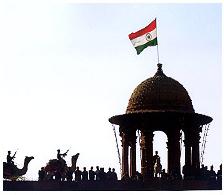Major players head for India in tussle for the student dollar

Outoing Harvard president Larry Summers with the chief minister of Indian state of Rajasthan in India.
MUMBAI (AFP) - In India's fast expanding job market Rajendra Balsaraf wants to stand out from the crowd. That is why the 23-year-old aspiring Indian hotelier plans to study in Britain.
"The number qualifying in hotel management is increasing day-by-day in India, the competition is getting harder," he says at an office of the British Council in Mumbai where he is investigating post-graduate opportunities. "To stand apart from others you have to do something different."
Provided he has the cash, Balsaraf should have plenty of options -- governments and educators from around the world have embarked on major campaigns to lure thousands like him to their institutions.
With the Indian economy rising and a wealthier class developing, students from the vast country represent a multi-billion dollar business opportunity.
Australian and British officials are now targeting them to try make up ground on the clear market leader, the United States, where Indians represent the largest group of foreign students.
Financial necessities are driving the effort by universities to woo overseas students in an increasingly competitive world market. In Australia, foreign students' fees make up about 30 percent of universities' operating budgets.
The heads of Harvard and Oxford both toured India in March and Australian education leaders joined Prime Minister John Howard to promote the country as an affordable destination for higher education.
"The fees are an important part of a university's budget," says Professor John Webb, Australia's counsellor for education and science, based in New Delhi. "Oxford, for all its financial strength, is still worried about its budget."
More than 80,000 Indians study in the US and the number is growing faster than from any other country.
Australia, with more than 26,000 students, says it is closing in on Britain in second place. Britain, although it had about 20,000 foreign students in 2004/05, specialises in short year-long or 18-month postgraduate courses with a higher turnover and issues more visas than Australia.
All three countries have seen sharp increases in enrolments with the Indian contingent to the US doubling in six years and numbers in Australia growing from fewer than 1,000 six years ago.
India's booming economy, growing at eight percent per year, has increased opportunities for many youngsters to study abroad with Indians favouring management, information technology and engineering courses.
Oxford University Chancellor Chris Patten said before visiting India that he wanted to alter the balance from US "Ivy League" institutions such as Yale and Harvard to leading British ones.
British Prime Minister
Tony Blair said in a video-link to New Delhi earlier this month that Britain offered "tremendous benefits" for Indian students.
Foreign students from outside the
European Union are an increasingly lucrative source of income for British universities as they pay higher annual fees than their home-grown and European Union counterparts.
But only 133 of Oxford's 17,700 students were from India, compared with 547 from China for in the past academic year, an Oxford University spokeswoman told AFP.
Patten was followed to India by Lawrence Summers, the outgoing president of Harvard University, who announced education tie-ups between the two countries as he travelled to New Delhi and Mumbai.
US officials say they remained confident of continuing as number one choice for Indian students.
"The US system of education is flexible and cutting edge and prepares them well for careers," says Jane Schukoske, executive director of the US Educational Forum in India.
However, leading Indian institutions said they were were also seeing growing numbers of students applying for places on their domestic courses.
One of the country's leading business schools, the Indian Institute of Management Ahmedabad, says more than 150,000 people have applied for one of the 250 spaces on its elite two-year post-graduate management programme.
"The number of candidates seeking admission to our programmes has not been impacted at all" by the overseas recruitment drive, says spokesman Ashok Shah.
But for Balsaraf, India is not an option.
Australia is his second choice and he considered the US but thinks he can make up the 18-month living expenses and course fees of about 15,000 pounds (26,000 dollars) through work placements in Britain.
"I worked in one of Mumbai's top hotels for six months but I wasn't happy with the career and growth opportunities. Doing this, you gain a lot of international exposure," he says.
- AFP

0 Comments:
Post a Comment
<< Home